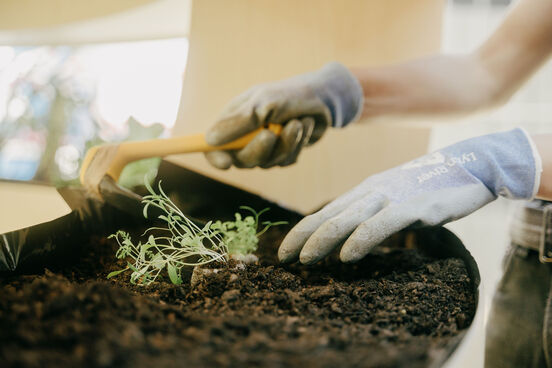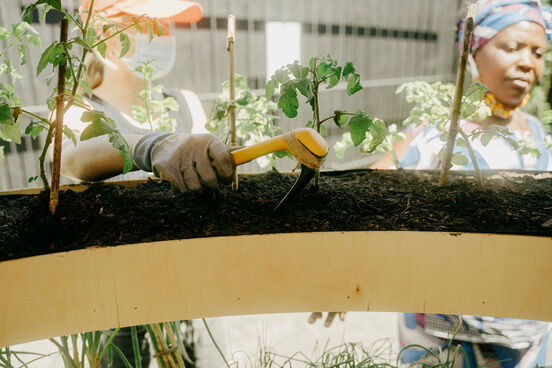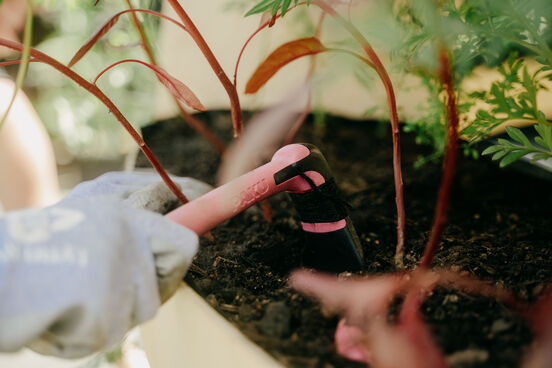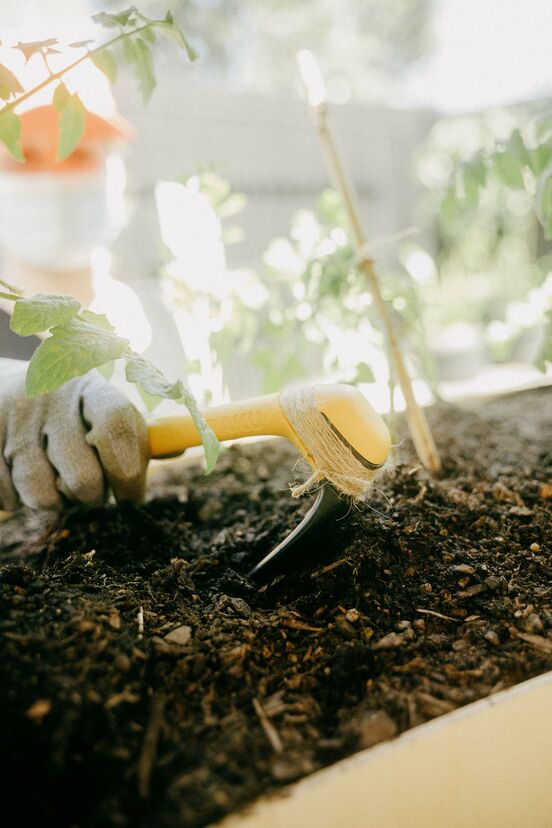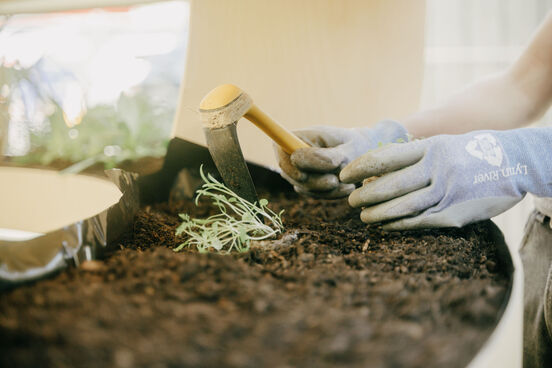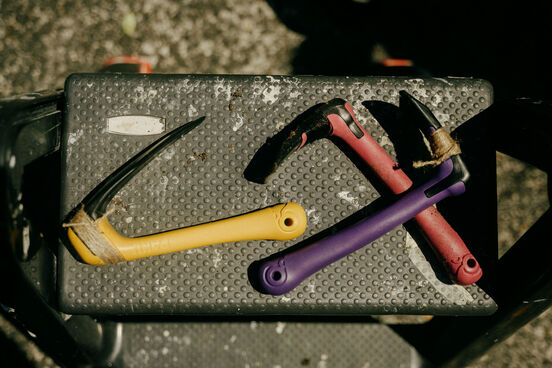-
Author
Paku Studio -
Date
17 Feb 2022
Essay
Interview with Paku Studio
Try the first products from Paku in The Growroom’s garden beds at Objecstspace from 15 – 20 February. Based in Te Whanganui-a-Tara Wellington, Paku combines mātauranga Māori (Māori knowledge) with the latest technologies to re-imagine objects in a bicultural way. Paku gardening tools are made from recycled nylon, and reference traditional Māori tools in their design.
Paku has provided versions of their Toki and Timo tools for use in The Growroom. Toki is a common tool, used in carving and, with a sharpened blade, for cutting. With a variety of different shapes, Timo is commonly used as a grubber for loosening soil.
To find out more about these tools and the work of Paku, we sat down for a chat.
—
Objectspace: Paku’s Toki and Timo are really useful, tactile objects, in stark contrast to art objects or museum collections of māori tools. Could you expand on the benefits and potential of contemporary usability for sharing mātauranga māori?
Paku: There are so many items, tools and ideas that are informed by mātauranga māori – most of them are displayed in museums and don't feel like they can be part of our lives outside of that context. At Paku we want to be a small part of breaking that wall by providing another link between the customary past of Aotearoa and our present.
A lot of people see the items and say, ‘Wow what a great reimagining māori weapon’. We want to show that māori made everything in their world, that the design language of mātauranga māori extends across all areas of life, and there is no reason why it can't be part of our contemporary lives.
We chose to design our first products for tamariki with the aim of introducing these concepts at an early age, making it a normal part of life. We want all people in Aotearoa to be and grow in a world where it won't be strange to have any item they interact with being informed by mātauranga māori.
OS: What are some of the biggest challenges when designing products for tamariki? How did Paku work through them?
Paku: Luckily, we both have young whānau and during the design process were both involved with the different early childcare places our tamariki attended (shout out to all the Kōhanga teachers and Playcentre whānau).
As with any good design project you should be incorporating all the different people and places that are important to your kaupapa. Using our tamariki as collaborators and incorporating the prototypes into their play helped us develop both the size and the shape of the tools, working through many iterations.
OS: Both the Toki and Timo arrive in parts and require simple assembly with a cord lashing. What inspired this design decision?
Paku: If you look at customary Toki, like many adze around the world, they were designed with the materials and technology available. Various hard materials (pounamu, flint and other stone) were used sparingly only for the blades, depending on the task required, with the easier to work and more available woods used for the handles. These components were then lashed together to make the final item.
We wanted this reflected in our version as well, and while we could have made our items single piece, or used a more modern connection method, there’s value in the aesthetic of the jute lashing that offsets the contemporary plastic of the blade and handle - it echoes those customary items.
It’s also a great jumping off point to get tamariki involved in all the different types of raranga that exist in the māori world.
OS: What specific tasks were each of these tools originally designed for? How did they once feature in day-to-day life?
Paku: The Toki has many variations, seen mainly in ceremonial use and carving. The type of Toki we took inspiration from is the Toki hengahenga, used as a hoe. (1)
The Timo is a specific gardening and agricultural tool used to loosen ground and furrow rows in which to plant seeds. (2)
OS: What are some fun ways for our tamariki to use their Paku Toki and Timo?
Paku: Since launching we have seen the items used in the garden, the beach, the river and in countless sandpits. We have received lots of feedback about how proud tamariki are about assembling the tools themselves and how they persevere to do so.
OS: You’ve done a lot of product testing to fine tune these tools – what’s a favourite memory of trying out the Toki or Timo with tamariki?
James Prier of Paku (Design Engineer): For me it was the community gardening days at our playcentre – I’d bring prototypes along and get the kids to try them in the garden and the sandpit. It was such great motivation to keep designing and iterating.
Johnson Witehira of Paku (Māori Design Specialist): I had a similar experience. Even taking the very early rough prototypes to kohanga here in Feilding and to my te reo classes, everyone was super excited. It was really exciting to see this much interest before we’d really even pushed things design-wise. I showed the 3D prototypes to a number of staff at the School of teaching and the School of Māori studies at Massey and also got really positive feedback. To have the idea validated by different Māori communities was significant.
OS: Paku’s products are made using a “locally sourced post-industrial waste stream nylon”, could you please break that process down for us?
Paku: As part of any industrial process there is waste, everything we purchase, consume and use –even if that product is sold as sustainable – has some cost to it, from the energy used to the waste that is created during its manufacture. Post industrial waste means anything discarded during the manufacturing process.
One of our early goals in designing these products was to get the kaupapa in the hands of as many tamariki and their whanau as possible. We landed on Injection moulding as the process that would give us the design flexibility needed and mass production at a low cost, but it did leave us with environmental concerns. When we approached potential manufacturing partners we found one in Te whanganui-a-tara who had a source of waste plastic that they had no way of using. We then designed the products with this material in mind. This plastic has already come from a recycled source so the Timo and Toki are giving it a 3rd life.
OS: How can we order Paku’s products?
Paku: We had a great kickstarter campaign that came to a close in November 2021, and Paku was the feature project on the kickstarter design and tech page in our last week. We had 418 backers from all over the world helping us to just under 450% of our goal and launched our website soon after. Retail and Tourism may become important to us later when things open up, but for now we are selling directly through the website
OS: How else can people support Paku’s awesome mission?
Paku: One of the most surprising things we learnt from the kickstarter we ran in 2021 was how generous people are. Our biggest selling reward was one called the ‘Mega Paku pack’ where someone buys a completed set of 4xToki, 4xTimo (all four colours) as well as the tamariki pukapuka, and then they nominate an early childhood centre or primary school to donate the items to. We have put this pack on the website, now the ‘Education Kete’ and would love to see this continue with as many education places as possible having more items that are uniquely of Aoteroa.
But besides purchasing our products for yourself or encouraging your local school, Kindy or Kōhanga to get some, just sharing the kaupapa of bringing more things inspired by mātauranga māori back into our contemporary lives is what we want more people to do.
OS: What’s up next for Paku?
Paku: While developing the Paku Toki and Timo we also reimagined other gardening tools, like the Kō and Kaheru – it would be great to expand on the hauhake range and show the diversity of customary tools that were made. We also have other projects for tamariki going on in the background, that we’re hoping to release later this year.
And also, thanks heaps to Objectspace for organising such a great exhibition and asking us to be a small part of it. At the end of the final week Objectspace have decided to donate the whole education kete to their local Kohanga - ka rawe team!
—
(1) http://nzetc.victoria.ac.nz/tm/scholarly/tei-BesSton-t1-body-d3.html, page 27
(2) https://teara.govt.nz/en/photograph/17367/timo
—
To find out more about Paku or get some tools of your own, visit their website and follow them on Instagram.
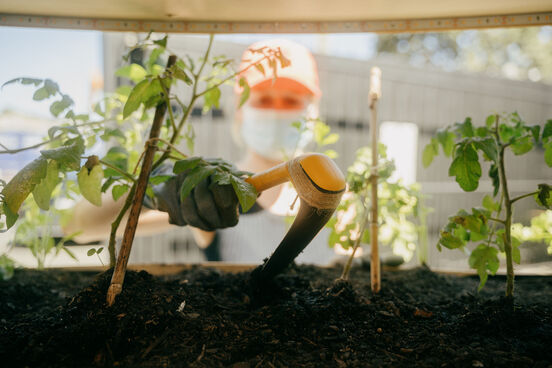
Paku tools at use in The Growroom at Objectspace. All photographs by David St George.
